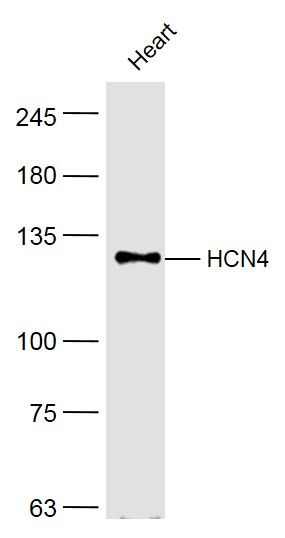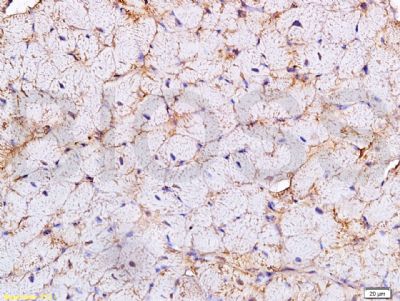产品中心
当前位置:首页>产品中心Anti-HCN4
货号: bs-1691R 基本售价: 780.0 元 规格: 50ul
- 规格:50ul
- 价格:780.00元
- 规格:100ul
- 价格:1380.00元
- 规格:200ul
- 价格:2200.00元
产品信息
- 产品编号
- bs-1691R
- 英文名称
- HCN4
- 中文名称
- 环化核苷酸调控阳离子通道蛋白亚型4
- 别 名
- HCN 4;Hyperpolarization activated cyclic nucleotide gated potassium channel 4; Potassium/sodium hyperpolarization activated cyclic nucleotide gated channel 4;Hyperpolarization activated Cyclic Nucleotide-gated channel 4; HCN4_HUMAN.

- Specific References (1) | bs-1691R has been referenced in 1 publications.[IF=0.00] Li, Yao-Dong, et al. "Association between Reversal in the Expression of Hyperpolarization-Activated Cyclic Nucleotide-Gated (HCN) Channel and Age-Related Atrial Fibrillation." American Journal of Case Reports 20 (2014): 2292-2297. WB ;PubMed:25404650
- 规格价格
- 50ul/780元购买 100ul/1380元购买 200ul/2200元购买 大包装/询价
- 说 明 书
- 50ul 100ul 200ul
- 研究领域
- 心血管 免疫学 通道蛋白
- 抗体来源
- Rabbit
- 克隆类型
- Polyclonal
- 交叉反应
- Human, Mouse, Rat, Pig, Cow, Rabbit,
- 产品应用
- WB=1:500-2000 IHC-P=1:400-800 IHC-F=1:400-800 IF=1:100-500 (石蜡切片需做抗原修复)
not yet tested in other applications.
optimal dilutions/concentrations should be determined by the end user.
- 分 子 量
- 129kDa
- 细胞定位
- 细胞膜
- 性 状
- Lyophilized or Liquid
- 浓 度
- 1mg/ml
- 免 疫 原
- KLH conjugated synthetic peptide derived from human HCN4:501-600/1203 <Cytoplasmic>
- 亚 型
- IgG
- 纯化方法
- affinity purified by Protein A
- 储 存 液
- 0.01M TBS(pH7.4) with 1% BSA, 0.03% Proclin300 and 50% Glycerol.
- 保存条件
- Store at -20 °C for one year. Avoid repeated freeze/thaw cycles. The lyophilized antibody is stable at room temperature for at least one month and for greater than a year when kept at -20°C. When reconstituted in sterile pH 7.4 0.01M PBS or diluent of antibody the antibody is stable for at least two weeks at 2-4 °C.
- PubMed
- PubMed
- 产品介绍
- background:
HCN4 is a member of the family of hyperpolarization activated and cyclic nucleotide gated (HCN) channels. HCN currents have been linked to pacemaker activity in the heart and brain, resting potential control, as well as neuronal plasticity. It has been shown that HCN4 channels function as receptors for sour taste, and are associated with pacemaker potential generation in the sinoatrial node.
Function:
Hyperpolarization-activated ion channel with very slow activation and inactivation exhibiting weak selectivity for potassium over sodium ions. May contribute to the native pacemaker currents in heart (If) and in neurons (Ih). Activated by cAMP. May mediate responses to sour stimuli.
Subunit:
The potassium channel is probably composed of a homo- or heterotetrameric complex of pore-forming subunits.
Subcellular Location:
Membrane; Multi-pass membrane protein.
Tissue Specificity:
Highly expressed in thalamus, testis and in heart, both in ventricle and atrium. Detected at much lower levels in amygdala, substantia nigra, cerebellum and hippocampus.
DISEASE:
Defects in HCN4 are a cause of sick sinus syndrome type 2 (SSS2) [MIM:163800]; also known as atrial fibrillation with bradyarrhythmia or familial sinus bradycardia. The term sick sinus syndrome encompasses a variety of conditions caused by sinus node dysfunction. The most common clinical manifestations are syncope, presyncope, dizziness, and fatigue. Electrocardiogram typically shows sinus bradycardia, sinus arrest, and/or sinoatrial block. Episodes of atrial tachycardias coexisting with sinus bradycardia (tachycardia-bradycardia syndrome) are also common in this disorder. SSS occurs most often in the elderly associated with underlying heart disease or previous cardiac surgery, but can also occur in the fetus, infant, or child without heart disease or other contributing factors, in which case it is considered to be a congenital disorder.
Defects in HCN4 are the cause of Brugada syndrome type 8 (BRGDA8) [MIM:613123]. A tachyarrhythmia characterized by right bundle branch block and ST segment elevation on an electrocardiogram (ECG). It can cause the ventricles to beat so fast that the blood is prevented from circulating efficiently in the body. When this situation occurs (called ventricular fibrillation), the individual will faint and may die in a few minutes if the heart is not reset
Similarity:
Belongs to the potassium channel HCN family.
Contains 1 cyclic nucleotide-binding domain.
SWISS:
Q9Y3Q4
Gene ID:
10021
Database links:Entrez Gene: 10021 Human
Entrez Gene: 330953 Mouse
Entrez Gene: 59266 Rat
Omim: 605206 Human
SwissProt: Q9Y3Q4 Human
SwissProt: O70507 Mouse
SwissProt: Q9JKA7 Rat
Unigene: 86941 Human
Unigene: 41082 Rat
Important Note:
This product as supplied is intended for research use only, not for use in human, therapeutic or diagnostic applications.
HCN4阳离子通道结构蛋白,具有调节心脏起搏的功能蛋白。
- 产品图片
 Sample:
Sample:
Heart (Mouse) Lysate at 40 ug
Primary: Anti-HCN4 (bs-1691R) at 1/300 dilution
Secondary: IRDye800CW Goat Anti-Rabbit IgG at 1/20000 dilution
Predicted band size: 129 kD
Observed band size: 129 kD Tissue/cell: rat heart tissue; 4% Paraformaldehyde-fixed and paraffin-embedded;
Tissue/cell: rat heart tissue; 4% Paraformaldehyde-fixed and paraffin-embedded;
Antigen retrieval: citrate buffer ( 0.01M, pH 6.0 ), Boiling bathing for 15min; Block endogenous peroxidase by 3% Hydrogen peroxide for 30min; Blocking buffer (normal goat serum,C-0005) at 37℃ for 20 min;
Incubation: Anti-HCN4 Polyclonal Antibody, Unconjugated(bs-1691R) 1:200, overnight at 4°C, followed by conjugation to the secondary antibody(SP-0023) and DAB(C-0010) staining

